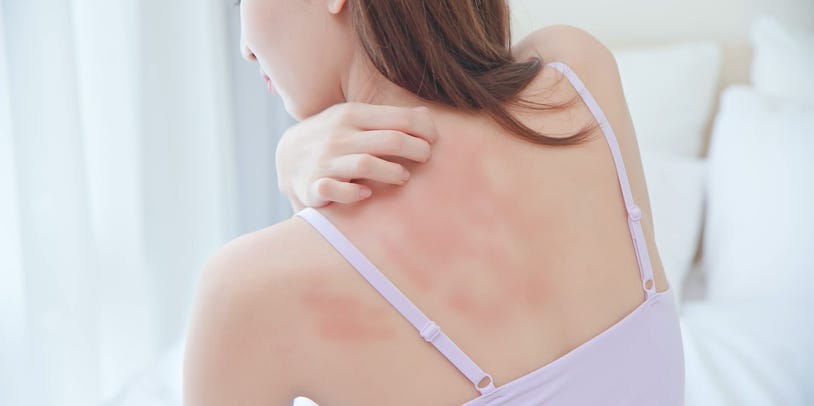
- A keto rash, aka prurigo pigmentosa, is a rash that results in red spots across the torso and back.
- The rash happens because eating a keto diet can trigger inflammation in your body.
- A keto rash is a sign that you should stop ketosis if you're on the diet for non-medical reasons.
- Visit Insider's Health Reference library for more advice.
The keto diet comes with a series of potential health benefits, but it can also have unintended consequences, including the keto rash.
This rash is a form of dermatitis called prurigo pigmentosa, and it triggers raised red spots across the back, shoulders, and abdomen.
The cause is unclear, however the rash usually resolves within a few weeks once you stop ketosis, but can leave lasting discoloration on the skin.
Luckily, most people who try the keto diet won't experience the rash. "Keto rash is very rare," says Marina Peredo, MD, a dermatologist with Skinfluence.
But in the event you do develop it, here's what you should know about the causes of keto rash and how to get rid of it.
What causes keto rash?
The rash occurs most often in young Asian women, but research shows it can happen to anyone, especially if they're following a keto diet.
Prurigo pigmentosa also appears in people who:
- Have eating disorders like anorexia
- Have auto-immune disorders including Sjogren's syndrome
- Are pregnant
Doctors aren't exactly sure what causes the rash, but it's believed that a change in the gut microbiome from sudden changes in eating habits can contribute, says Kristi Artz, MD, medical director for Spectrum Health Lifestyle Medicine.
"Healthy gut microbes typically thrive on high fiber foods which are often removed from a keto diet," she says.
What if I get a keto rash?
In general, keto rash is a sign that you should stop ketosis, because it's not beneficial for your body, Artz says.
The rash is a sign of inflammation and may indicate that the keto diet is causing inflammation elsewhere in your body, she says.
"Keto rash is just one additional manifestation of inflammation that is often produced by following a keto diet," she says.
Here are five ways to get rid of a keto rash. Some require you to go off the keto diet, but if you must stick with it due to medical reasons, there are tips for those circumstances, as well.
1. Eat more carbs
Stopping ketosis will help alleviate the rash. To end ketosis, you simply have to eat more carbohydrates. But the type of carb you eat is important.
Artz recommends focusing on fiber-rich fruits and vegetables like bananas and leafy greens to help rebalance your gut microbiome.
"Reintroducing fiber-rich whole plant foods will likely result in a decrease in total body inflammation and resolution of the rash," she says.
2. Eat anti-inflammatory foods
Prurigo pigmentosa is a form of inflammation, so following an anti-inflammatory diet can help fight it.
"Complex carbohydrates found in whole grains, beans, legumes, fruits and vegetables are health-promoting and fight inflammation," Artz says.
Along with complex carbs, foods rich in healthy fats — like salmon and olive oil — as well as nuts and berries are all part of an anti-inflammatory diet.
3. Take antibiotics
If you have a condition like epilepsy that requires you to follow a keto diet, then changing your eating habits isn't an option.
In this case, you may be able to treat the rash without ending ketosis by using antibiotics.
Doctors aren't entirely sure why antibiotics work, but they're thought to change the movement of white blood cells around the rash, which diminishes symptoms.
If you don't have a medical cause for following the diet, it's best to listen to your body and change your eating habits rather than taking a medication, Artz says.
4. Adjust your exercise routine
Exercise has powerful anti-inflammatory properties and may help the rash resolve quickly, says Artz. Opt for low-stress exercises like walking or yoga.
There's one exception: endurance exercise for more than two hours can promote ketosis and possibly make the rash worse, says Peredo. If you've been exercising for long periods of time, consider scaling back until the rash is resolved.
5. Address nutritional deficiencies
Most keto diets are not well-rounded and can lead to deficiencies in certain nutrients. That, in turn, can cause skin conditions including dermatitis, although this is different from keto rash.
"Keto diets high in animal proteins and fats followed over a period of time may cause deficiencies in vitamin C and other antioxidants and micronutrients found in whole plant foods," says Artz.
Addressing deficiencies with a more balanced diet and possibly a multivitamin can help address keto rash.
Treating keto rash and when to see a doctor
While your rash persists, you should moisturize the area, says Peredo. Try to avoid touching or rubbing it, and opt for loose-fitting clothing, she says.
Keto rash generally resolves on its own within a few weeks of stopping ketosis, but it can leave a reticulated pattern — similar to a leaf, or giraffe — on your skin indefinitely.
If your rash spreads over most of your body or doesn't seem to be resolving once you stop the keto diet, see a doctor, says Artz.
You should also see a doctor immediately if the rash is accompanied by fever, chills or other concerning symptoms.
Insider's takeaway
Keto rash is rare. Doctors aren't sure why it happens, but they think that changes to the gut microbiome, and subsequent inflammation, caused by lack of fiber might contribute.
The rash is an indication that your body is not tolerating the ketogenic diet well, Artz says, and the best treatment is stopping ketosis, unless you're on a keto diet for a medical reason.